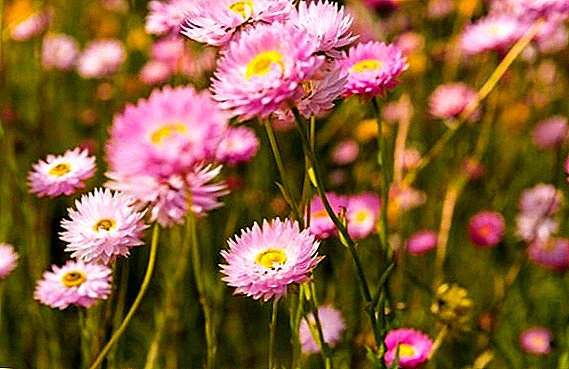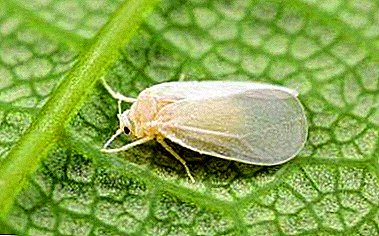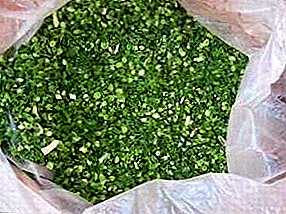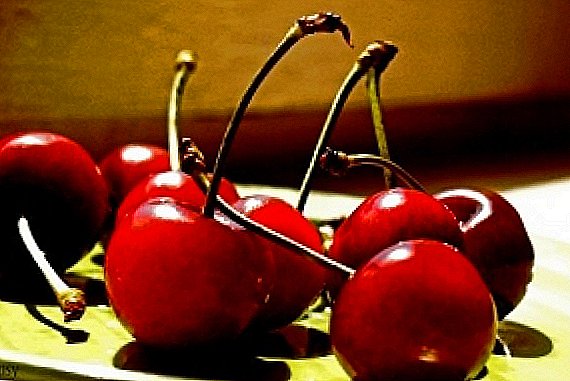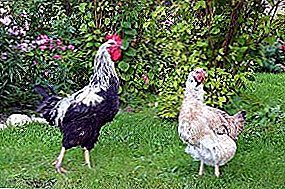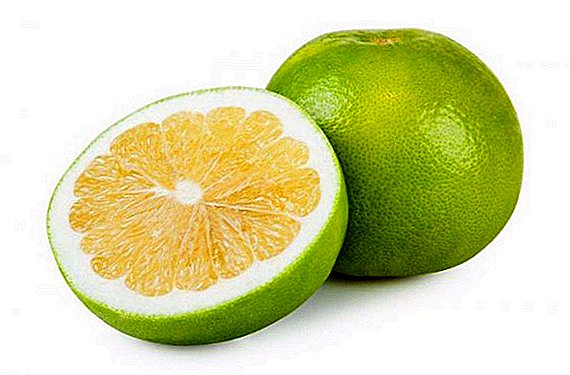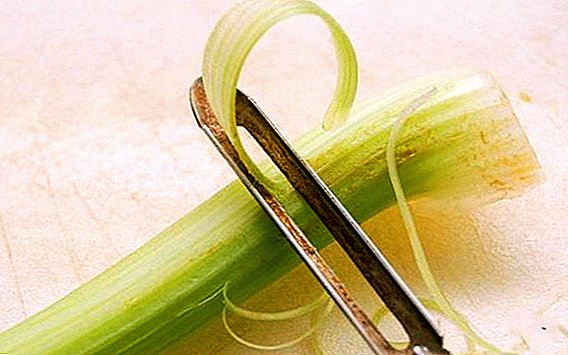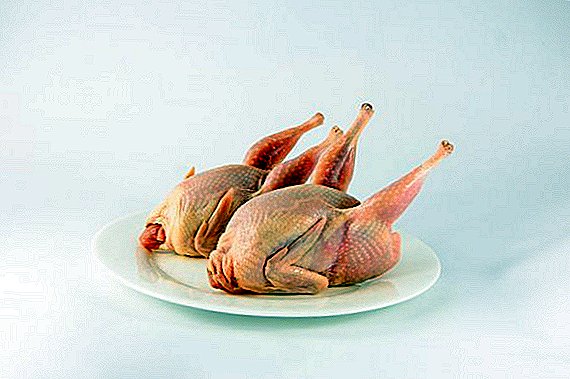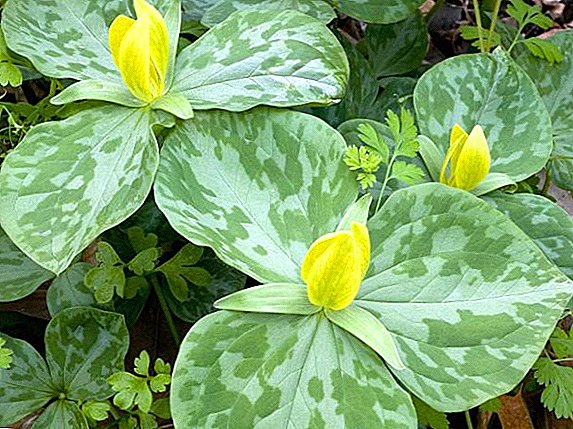 Trillium - It is a perennial plant that grows in the wild on the territory of East Asia and North America. Due to its beautiful exotic appearance, trillium has spread to different parts of the planet and is used as a decorative element of landscape design. In this article we will consider a detailed description of trillium, its species, as well as the basic rules for planting and caring for a plant.
Trillium - It is a perennial plant that grows in the wild on the territory of East Asia and North America. Due to its beautiful exotic appearance, trillium has spread to different parts of the planet and is used as a decorative element of landscape design. In this article we will consider a detailed description of trillium, its species, as well as the basic rules for planting and caring for a plant.
Botanical description
Trillium genus refers to the family of Lilyns and counts 30 species. The plant has scaly leaves with elongated stems and thick roots. The root of the flower reaches no more than 3-4 cm in length. Some species are characterized by oval sessile or rhombic leaves.
In addition to the trillium, the family of the Lileins also includes: tulips, goose onions, scilla (scilla) and lilies.

Translated from Latin "trillix" means triple, which exactly describes this plant. The fact is that a trillium has 3 petals on a flower, 3 sepals and 3 stamens, as well as 3 leaves on a stalk. Trillium flowers are represented by single buds, which can be pink, yellow, white-green, purple, burgundy.
Considering that trillium species are numerous, they are easily distinguished by the location of the flower. Some species do not have a pedicle, and the bud is planted directly on the leaves; in other species, the flowers are planted on straight small pedicels. 
The flowering of almost all types of trillium occurs for a period from April to May plants bloom for a short time from 5 to 15 days. After flowering, a faceted green box appears in place of the bud, which may eventually acquire a different color.
Popular species
As mentioned earlier, there are quite a few types of trillium, but consider the most popular of them, which are used in landscape design and can be grown at home.
Large-flowered (terry)
This type of trillium is the most famous and sought-after, as it is easiest to grow at home. 
Did you know? In America, the large-flowered trillium is called the large white trillium, and in Canada this plant is a symbol of the province of Ontario.
The flower is common in the United States of America in the south of the Great Lakes and in the Canadian provinces of Quebec and Ontario. The flower grows in deciduous or mixed forests. The plant reaches a height of 30, sometimes 50 cm, has large flowers of snow-white color, which in the process of flowering become slightly pink. Along the edge of the petals are slightly wavy, corrugated. The older the trillium, the larger it is, respectively, and the flowers are larger. By the fourth year, the buds on the large-flowered trillium can reach maximum sizes - up to 10 cm in diameter. 
Kamchatka
Kamchatka trillium possesses maximum decorative effect, therefore it is in demand in landscape design. It grows on the island of Sakhalin, the Kuril Islands, is distributed in the south of Kamchatka, and also grows in the wild nature on the island of Hokkaido, in the north and east of China and in Korea. This plant grows in forests, valleys, on mountain slopes and well humid places. Flower reaches 40 centimeters high in rare cases, 60 cm, has thick, but short roots. Blooming Kamchatka trillium buds white, the petals of which are rounded. Ripening occurs in August. 
Did you know? The inhabitants of Kamchatka eat trillium fruits. In Japan, they are also considered very useful and are used to treat diseases of the intestines and as a means to improve digestion.
Wedge-shaped
Wedge Trillium reaches 40 centimeters in height, has very beautiful leaves of dark green color with silvery spots. Trillium blooms at the beginning of June, the buds are painted maroon-wine color. A flower grows in the United States. Prefers moisture and well-drained forest soils. 
Sedentary (session)
Seated trillium is widespread in the eastern part of the United States, it grows on clay and calcareous soils, in the floodplains of rivers, but it can also be found in mountainous areas, often interspersed with other types of trillium. The plant is quite small, only about 25 cm tall leaves are colored green or bluish-green, sometimes have a characteristic silver shine, less often - bronze spots, which disappear during the flowering period. The bud of the plant is colored red-brown or yellow-green, which eventually becomes red. 
Turned away
In the wild, it is common in the Mississippi coastal area, and can also be found along the Missouri and Ohio rivers. Tall plant reaches 50 cm The buds have a dark red color, sometimes a purple hue. The buds, in comparison with the size of the plant, are quite small, so this species is very rarely chosen for growing at home. 
Green
Trillium green - quite a rare species, in height reaches 50 cm has lanceolate sessile leaves that are covered with light spots. The petals of the plant are brown-purple in color, which gives the trillium a rather exotic and decorative look. The flower is common in forests near the Missouri and Ohio rivers. 
Application in landscape design
Trillium is considered an exotic plant, but recently it has been increasingly used in landscape design to create unique compositions. In order to maximize the beauty of trillium, it is necessary Correctly combine it with other colors. It should be noted that separately planted flowers look no less impressive than in composition with other plants.
In all phases of growth, trillium does not lose its decorative effect: when green leaves with various shades and patterns appear, it creates a dense green carpet, on which flowers of different shades appear over time, and in late summer and early autumn, berries with seeds of different shades and colors appear in the place of flowers. Trillium can be planted in combination with rhododendron, which also prefers shady places. 
You will also create a beautiful composition and imitation of a wild forest by planting a trillium in the garden.
The flower can also be combined with any plants that feel well in the shade - crested birds, anemone, uvularia, meconopsis, ferns.
The plant will be Great addition for flowerbeds, which are decorated with snags or decorative stone and give a more spectacular view of your garden or yard.
If you want to grow trillium in flower beds, learn how to make flower beds with your own hands from wheel tires.

Growing and planting
As you know, trillium is quite difficult to grow at home, and some species are particularly demanding care. Therefore, we consider the main nuances of trillium care in order to spend the minimum amount of time and get a good result in growing this plant.
Location and lighting
The choice of a place to plant trillium must be approached responsibly, because this criterion directly influences the further development and, in general, the survival of the plant. A prerequisite is planting a flower on well shaded areas where direct sunlight does not fall. To do this, select places under the canopy of trees or tall shrubs that create a dense shadow throughout the day.
Like trillium, shade-loving plants are also: ageratum, amaranth, begonia, annual asters, kobeya, kosmeya, dahlia, snapdragon, bidens, cloves, gatsaniya (ganiya), ipomeya, statice and lobelia.

Substrate, fertilizer and fertilizing
It is necessary to plant trilliums on fertile soil, the flower will feel especially good if maple, linden, ash, chestnut or oak trees grow close to where the soil is enriched with humus from the leaves. The soil where the plant will be planted must be slightly acidic or neutral.
If the soil has a high content of humus, then fertilization is not needed, but do not forget about spring dressing. For this, it is better to use purchased mineral fertilizers for ornamental flowering plants, which should be applied in accordance with the instructions on the package. If the soil is not enriched with natural fertilizers in the form of humus, it is recommended in early spring and late autumn to mulch the land with compost leaf earth. 
Important! It is necessary to pour mulch with a thin layer in order not to interfere with the normal growth and development of the plant, especially in the spring period.
Watering and moisture
It is very important to maintain the soil on which trillium grows, wet. To do this, in dry weather, water the flowers with plenty of liquid.
If the flowers grow near the trees, then you can not worry much about the humidity - rare watering will be enough, since the soil of the trees remains moist for a long time. 
Breeding
Propagate the plant in several ways, among which there are division by bush and seeds, Therefore, we consider these methods of reproduction in more detail.
Dividing bush
More simple and easy Trillium breeding method is the division of the bush. This method is applied at the end of the summer, for this the flower is dug up by the roots and neatly divided into pieces so that each of them has buds. Thanks to this method of division, the awakening of dormant buds is stimulated, which contributes to faster germination. Cut parts are planted in a permanent place of growth. 
Seeds
This breeding method is considered more time consuming and difficult but it is also often used enough to propagate a trillium.
In August, when seed boxes appear on the plants, they are harvested and immediately sown in the soil.
Important! Seed germination can be accelerated through stratification.

This requires a small container that is filled a mixture of wet peat with sphagnum in equal amounts. The soil is well watered, the container is wrapped in a moisture-proof film and sent to the refrigerator for 3 months. After the specified time has elapsed, the container is taken out of the refrigerator; the film is transferred to a dark room without unfolding. In this state, it is necessary to leave the seeds for another 3 months, after which the seeds are sent back to the refrigerator for 3 months and are delivered in April. Sprouted seeds are planted in open ground at the end of May, so in two weeks the first shoots appear.
Wintering
Even taking into account the fact that trillium belongs to frost-resistant plants, as an exotic species it is still covered for the winter to eliminate the risk of freezing. To do this, before the first frost plants fall asleep foliage, bark or mulch in the form of compost. 
Pests and diseases
Trillium is sufficiently resistant to diseases, in rare cases, during heavy rainy seasons or due to excessive watering, the plant can affect gray rot In this situation, it is no longer possible to save the flower, so make sure that there is no stagnation of water and the soil is not excessively moistened.
Gray decay most often affects plants such as zucchini, kalanchoe, geranium, currants, orchids, raspberries, peaches, hydrangea, petunia, almonds and carrots.

Among the pests that affect the normal development of the flower, emit snails and slugs, especially often they settle on young trilliums. You can fight pests by collecting them manually, or sprinkle around each plant. "Metaldehyde".
In addition to trillium, slugs are also pests of strawberries, pumpkins, cloves, phloxes, cacti, cabbage, potatoes, rhododendrons, cucumbers, cannes, and autumn crocus (colchicum).Thus, trillium is not easy to grow at home, but if you make some effort, then as a result you can get an incredible beauty flowering lawn in your yard. In order for the growing process to be as clear and simple as possible, it is necessary to take into account the peculiarities of the plant and follow the recommendations for trillium care.


